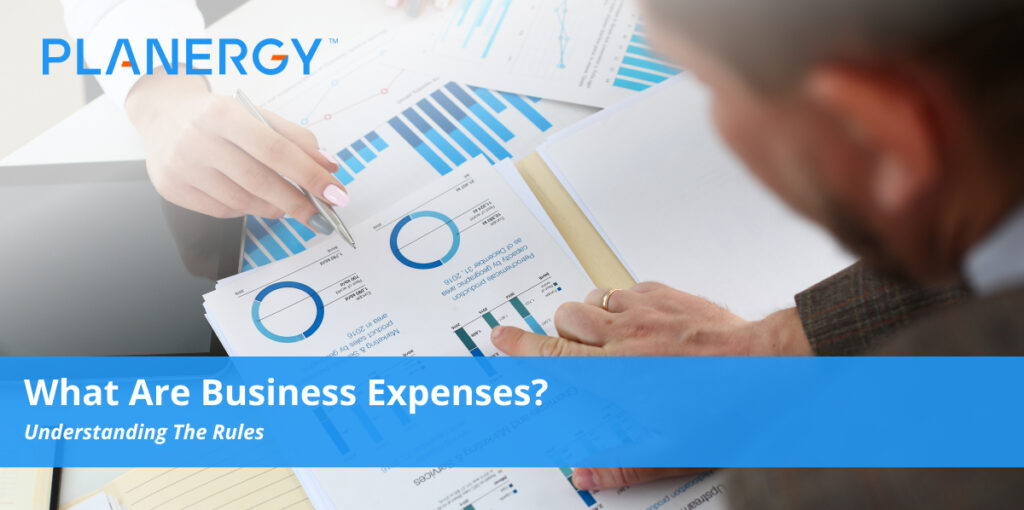A business expense is a cost incurred throughout the ordinary course of business and applies to small businesses and large corporations. Business expenses are reported on the income statement.
Business expenses are subtracted from revenue to arrive at a company’s taxable net income. You may also hear business expenses referred to as deductibles.
Generally speaking, organizations have some limitations and special considerations for business expense deductions. They are usually divided into capital expenditures and operating expenditures.
Section 162 of the Internal Revenue Code (IRC) from the Internal Revenue Service (IRS) provides the guidelines for business expenses. Under these rules, businesses can report any expenses that may be necessary and ordinary.
Ordinary means that the expense is common for the industry and most businesses in the same line of work would potentially expense these things. Necessary means the expenses assist in conducting business, the expenses are appropriate, and a business owner may not be able to handle the business if the expenditure isn’t made.
An expense does not have to be indispensable to be considered a necessary expense.
Expenses that meet the definition of ordinary and necessary for business purposes are expensable and therefore tax-deductible. Some business expenses can be fully deductible while others are only partially deductible.
The income statement is the main financial statement companies use to record their expenses and determine their taxes.
Companies typically have three categories of expenses that are broken down by direct costs, indirect costs, and interest on the income statement.
Small businesses, according to the IRS, are those that average annual gross receipts of $25 million or less over a trailing three-year period. This three-year lookback rule ensures companies cannot be divided into multiple entities to come in under that threshold.
Types of Costs on the Income Statement
Direct Costs
The value of your on-hand inventory at the beginning and end of each tax year is used to determine the cost of goods sold (COGS), which is generally the largest direct cost for many companies.
COGS is subtracted from total revenue to determine the gross profit for that year. Any expenses, including direct labor, included in COS cannot be deducted again. Direct costs may be fixed or variable.
Indirect Costs
Indirect costs are subtracted from the gross profit to determine operating profit. Indirect costs include general expenses, depreciation, marketing costs, and executive compensation.
Operating profit is also known as earnings before interest and tax.
Depreciation
Expensing business assets is generally done by depreciation. Depreciation is a tax-deductible expense on the income statement. It is considered an indirect expense.
These expenses can be deducted over a number of years. Examples include the cost of computers, business property, furniture, equipment, vehicle fleets, and more.
Gifts, Meals, and Entertainment Costs
These are costs the IRS has restrictions on. Generally speaking, you can only deduct 50% of meals and entertainment expenses, even if you reimburse your employees 100%.
However, the 50% limit doesn’t apply to expenses for meals and entertainment you treat as compensation to an employee who the recipient of the meals or entertainment and wages are subject to federal income tax withholding.
It is also not applicable to meals or entertainment expenses if the recipient is not an employee and has to include those expenses in gross income as compensation for services or as a prize or award.
It also does not apply to meals and entertainment costs associated with:
- Sales of meals or entertainment to the public
- Providing meals or entertainment to promote goodwill
- Director, stockholder, or employee meetings
- Trade association meetings or seminars.
Interest Expenses
The final part of the income statement handles expenses for interest and tax. Interest is the last expense a company subtracts to determine its taxable income, also known as adjusted taxable income.
For loan interest to be deductible, its purpose must be business-related.
The list of allowable and fully deductible expenses includes common business expenses such as:
- Advertising and marketing expenses
- Credit card processing fees
- Education expenses (including training) for employees
- Certain legal fees
- License and regulatory fees
- Wages paid to contract employees
- Employee wages
- Employee benefits programs, including health insurance, commuting benefits, life insurance, adoption assistance, education assistance, etc.
- Equipment rentals
- Insurance costs, including business insurance
- Interest paid, like mortgage interest
- Office expenses
- Office supplies
- Maintenance and repair costs
- Office lease, rent, mortgage
- Utility expenses
Partially deductible expenses include:
- Self-employment taxes: If you’re self-employed, you can deduct half of your self-employment tax liability.
- Meals and entertainment: As mentioned above
Some expenses have to be capitalized, rather than deducted – the costs that are part of your investment in your business. These are business start-up costs, assets, and improvements.
If you are unsure about your deductible business expenses (the expenses you can write off of your tax return), speak with a certified public accountant (CPA) or tax professional who specializes in business taxes.
All businesses will have expenses to track. These expenses can help reduce your overall income tax liability.
Personal Expenses and Business Expenses
In some situations, expenses incurred by a small business owner may be both personal and business-related. For instance, a small business owner may be able to use his car for both personal and business use.
In situations like this, the portion of miles used for business purposes can be deducted, using the standard mileage rate, found in IRS publication 535. In terms of home offices, costs associated with the portion of the home that is exclusively used for business are generally deductible.
To be eligible for the home office deduction, the area of your home cannot be used for anything else. If for instance, your office area is also in your dining room, if you eat meals there, or allow your children to use the computer for their homework, you do not qualify. The IRS may request photos of the office area as proof.
There are some non-deductible expenses such as lobbying costs, fines, penalties, and contributions made to political candidates or parties, any bribes, legal fees incurred to obtain business assets, demolition expenses, and educational expenses incurred to help you meet minimum requirements for your business.
Tips for Handling Business Expenses
- Separate business and personal expenses
- Keep good records
- Know what business expenses you can deduct
- Make a budget (and stick to it!)
Even sole proprietorships should get a separate bank account to make it easier to handle business expenses throughout the year.
Information in this blog post is intended for general purposes only. It is not meant to replace professional tax advice, and should not be construed as such.
Depending on the type of business you operate and your place of business, you may not be able to claim all business tax deductions and capital expenses.




